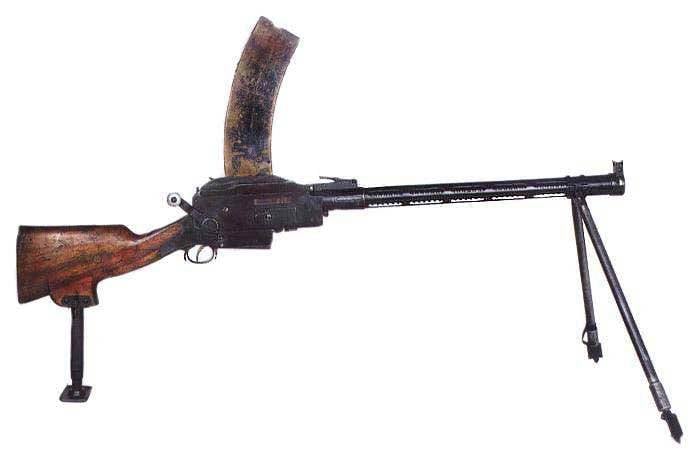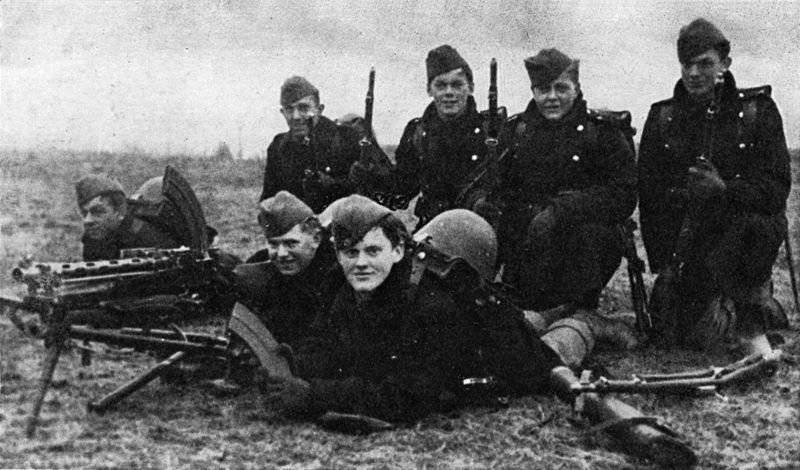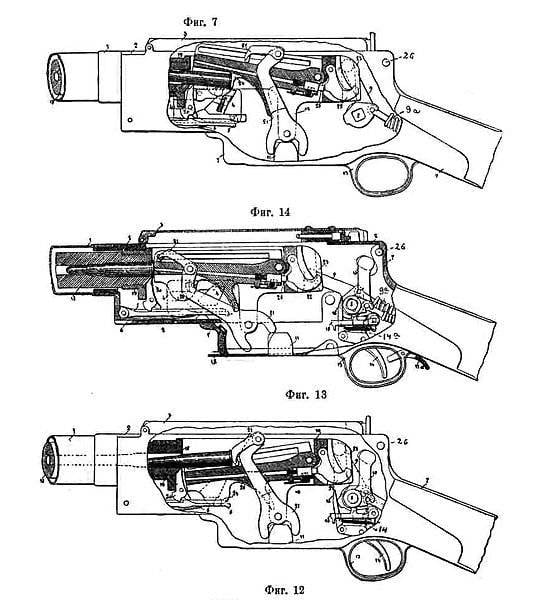Manual machine gun "Madsen"
During the Russo-Japanese War, Russia acquired the Madsen 1250 machine guns, adapted to the Russian three-line rifle cartridge. The Madsen machine-guns had a sight notched up to 2,4 thousand steps (1705 meters). To hide deliveries neutral Denmark weapons in a belligerent country, it received the faceless designation of a “gun-machine gun of the 1902 model of the year” in Russia, but by the 1914 year it was more often mentioned under its own name. In 1915, these machine guns were assembled and delivered to the fronts, but before being sent, I had to fix some of them at the Sestroretsk plant.

In the automatic machine gun was implemented scheme with recoil barrel with a short course. The barrel bore was locked by a swinging bolt, the axis of which was fixed in the receiver - in fact, it was an automated swinging Martini system. During the course of the moving system, the protrusion of the shutter slid along the shaped groove of the duct guide. The protrusion, falling into the sloping portion of the groove, raised the bolt, thus unlocking the barrel. At the same time the rotary ejector removed and removed the cartridge case. After that, the shutter moved to the lower position, opened the receiver, where the next cartridge was fed. The moving system moved to 50 millimeters. The mobile system returned to the forward position with the help of a spring acting through a special lever. While the system was moving forward, the cartridge was sent to the chamber through a special device. After that, the bolt lifted locking the barrel bore. The scheme used to shorten the receiver and ensure reliable locking, but at the same time complicated weapons. The cartridge moved at such a curved trajectory at the time of submission that the reliability of work was theoretically impossible. It is said that the most remarkable thing about this system was not that it worked well, but that it worked. The relatively low rate of fire did not give the opportunity to achieve intense fire, but in combination with massiveness, made the Madsen machine gun more manageable, which apparently had an impact on its popularity.
Kurkov percussion mechanism had a helical combat spring. The trigger made it possible to conduct continuous and single fire; the translator was located at the rear of the trigger guard, limiting the turn of the trigger. Swing shutter handle was on the right side of the casing. During firing, the handle remained stationary, fixing itself on a special rack in the forward position.

The barrel, which has transverse fins along the entire length and was fastened with a screw joint in the receiver, was enclosed in a casing with several rows of oval holes. On the casing, a sector-oriented sight and a front sight were mounted, there was a recess under the bipod clip. A sector box magazine, designed for 25 cartridges (the upper position of the magazine, which is the most convenient for its quick change, will be used in many systems of manual machine guns) was placed just above the left, so the front sight and rear sight shifted to the right. Bipods - tubular, straight, with hinged legs and tips. The machine gun was equipped with a wooden butt with a pistol protrusion of the neck. The design had 98 parts.
In addition to Russia, the machine gun "Madsen" was adopted in Brazil, Bulgaria, China, Denmark, Mexico, Uruguay, Norway, Estonia, Finland. The last combat use of “Madsena” in our country was obtained in the Great Patriotic War as a weapon by the partisans - as a rule, they were Estonian machine guns “Madsen”, which the Red Army acquired after the Baltic republics joined the USSR in 1940.
Order discharging Madsen light machine guns: Turn on the fuse located above the trigger guard on the left by turning up its flag. By clicking on the latch behind the store to separate it. Rotate the charging handle all the way back. Turn off the fuse and pull the trigger.

The procedure for partial disassembly of the Madsen light machine gun:
1. Unload a machine gun.
2. Open the lid of the box and press its latch forward.
3. Separate the back plate by unscrewing the contactor.
4. Remove from the box moving system.
5. Separate the rammer by pushing the axle.
6. Remove the bolt axis, separate the bolt from the receiver.
7. Pull out the fuse to separate the safety clip.
Reassemble in the reverse order.
Technical characteristics of the Madsen light machine gun ("model 1902 of the year"):
Cartridge - 7,62-mm sample 1908 of the year (7,62x53);
The mass of the machine gun with bipod and equipped magazine - 8,92 kg;
Machine gun length - 1120 mm;
Barrel length - 590 mm;
Grooves - 4 right;
The length of the stroke rifling - 240 mm;
Sighting range - 1705 m (2400 steps);
The rate of fire - 400 shots per minute;
Combat rate - 200 shots per minute;
Magazine capacity - 25 cartridges;
The height of the line of fire - 410 mm.
Based on: S. Fedoseev - Machine Guns in the First World War
Information